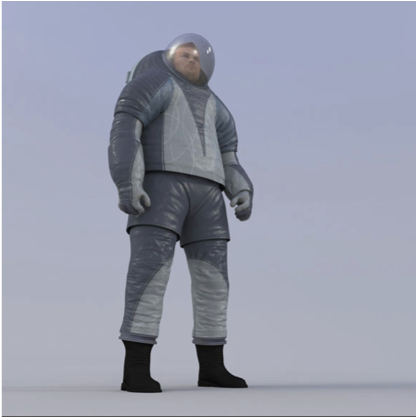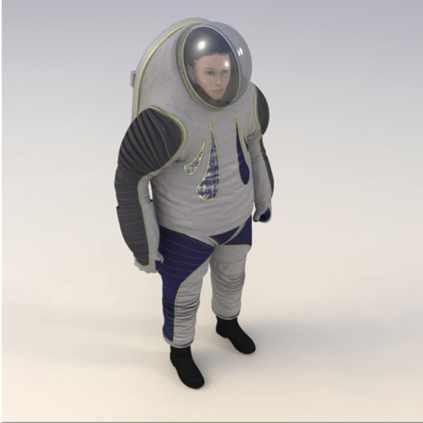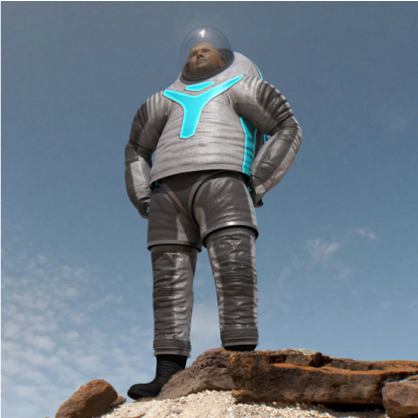SPACE IS BECOMING AN increasingly commercialised industry. With competition from private investors, NASA are no longer the de facto masters of the universe. To reinstate their position, NASA has recently sought public engagement to counteract competition from emerging corporations including Virgin Galactic and SpaceX. Their latest initiative invited audiences to vote on the design of their new generation of spacesuit, and as a result the designs incorporate elements of contemporary fashion in an effort to gain popularity.
This year NASA launched a website dedicated to a public vote on their next generation of space attire. The website offered a selection of three spacesuits, inspired by principles of biomimicry and trends in wearable technology.1 These are the latest in NASA’s Z-series of spacesuits. The previous suit, the Z-1, was named one of Time magazine’s best inventions of 2012, thanks to its ground-breaking application of 3D printing in the formation of impact-resistance structures.2 This design was lauded primarily due to its innovative functionality. The new design, the Z-2, incorporates similar technologies and, crucially for voters, it also looks stylish.
In terms of basic structure and functionality, the three designs offered to voters are identical, differentiated only by superficial aesthetic elements. One of the designs, titled the ‘Biomimicry’ suit, contains an electroluminescent wire which decorates the suit in low lighting conditions. Another competing design, the ‘Technology’ suit incorporates a bold chest insignia, and the ‘Trends in Society’ suit – the most overtly aesthetic design of them all with its contrast stitching – is reflective of what every day clothes may look like in the not too distant future and takes inspiration and design elements from sportswear.



The superficiality of these choices invites questions about limits to the audience’s expertise and the importance of aesthetics in an increasingly commercialised field. NASA have had to negotiate the conflict between the value of audience engagement with the fact that few audience members are qualified to make judgements about the suitability of spacesuits for extra-terrestrial environments. It is reasonable to assume that most voters have no experience of space travel, and are far less qualified than NASA employees to make informed decisions about the functionality of any particular spacesuit. Therefore, in order to offer voters an ostensibly significant level of audience involvement, their influence must be restricted to superficial aesthetic elements, forced NASA designers to consider the factor of ‘style’.
The consequence of this vote is that NASA suits are beginning to incorporate elements of fashion. It has become necessary for the suits to mirror trends in contemporary fashion design, drawing on trends for vibrant colours and sportswear, combined with visions of the future in recent sci-fi film costumes.
Functional aspects of the suit are, arguably, more essential than aesthetic aspects, however, in the eye of the untrained beholder, it is naturally the stylistic aspects that differentiate one design from another. It is this apparent importance of style, in contrast to the actual importance of functionality, which gives votes the impression of power and control. Historically-held notions about the ‘nobility of sight’ have caused audiences to assume the primacy of visual features, stylistic decisions may therefore appear more important than they actually are, giving voters the impression that they are contributing significantly to the future of space exploration.
Further questions are raised about why the general public are more qualified to make decisions about fashion than about technology. Why is it that a layperson is trusted to select an element of style but not an element of utility? Style, like all fashion, is essentially concerned with surface decoration, and often accused of being frivolous.3 The suit serves its purpose regardless of its appearance. NASA’s invitation to voters is therefore essentially worthless to astronauts, but vital to the public perception that they are engaging with their audience. In an increasingly commercialised industry, NASA must stay ahead of the game not just in technical innovation but also in terms of public image. They must present themselves alongside reality television and the numerous other commercial ventures that use public votes to direct their decisions, prompting a reflection on the value of public opinion and appeal when science meets fashion.
Barbara Brownie is a researcher and writer. She is also lecturer in fashion history and theory at the University of Hertfordshire.
Holpuch, Amanda. ‘Nasa says new spacesuit one small step towards sending mankind to Mars,’ The Guardian [online]. Accessed 30 April 2014, http://www.theguardian.com/science/2014/apr/30/nasa-spacesuit-zseries-new-design-mars ↩
NASA, ‘The NASA Z-2 Suit’, 2014. http://jscfeatures.jsc.nasa.gov/z2/ ↩
Roche, Daniel and Birrel, Jean. ‘The Culture of Clothing’. Cambridge, UK: Cambridge University Press, 1994, pp.502 ↩